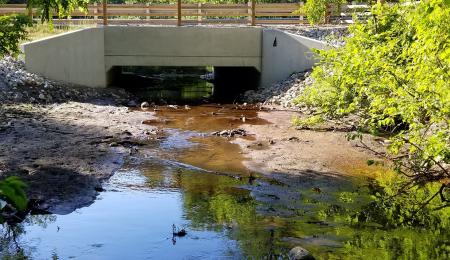Stream Crossings
Where the river meets the road: stream crossings, culvert permitting and design standards.
Our streams are home to fish and other valuable aquatic life. As they travel to eat, spawn and reach habitat, the streams' waters carry nutrients, sediment and organic materials downstream, ultimately reaching the Atlantic Ocean.
At least 17,000 road-stream crossings (such as culverts, bridges and arches) cross New Hampshire's waterways. Many such crossings are now too old, too damaged or too small. When they become plugged, they can cause flooding. This damages the roads' structural integrity, erodes the landscape and prohibits fish from migrating.
Over the past decade, to help address the impacts of inadequate crossings on river systems and public safety, NHDES has taken several key steps. Permitting rules for stream crossing structures were adopted in 2010; including the creation of a Culvert Maintainer Certification program, in partnership with University of New Hampshire, designed specifically for municipal employees and state transportation staff. Together with partners, we launched the Resilient Tidal Crossings Project for our coastal area in 2018. And our New Hampshire Geological Survey, Wetlands Bureau and other state agencies led a multiagency effort to assess and inventory the conditions of stream crossings statewide, known as the New Hampshire Stream Crossing Initiative.
Wetland Permitting Tips to Consider
This 7-minute video offers tips to consider for “standard dredge and fill” wetland permit applications in New Hampshire.
Technical Guidance
Related Content
New Hampshire Stream Crossing Initiative
The New Hampshire Stream Crossing Initiative (NHSCI) is a multi-agency group that collaboratively works to survey and assess stream crossings across the state. The NHSCI provides the tools needed for stakeholders to make data-driven decisions for targeting stream crossing upgrades to support transportation safety, flood resiliency and stream connectivity for fish and wildlife.
Stream Crossing Assessments
We have developed a stream crossing assessment protocol to evaluate how crossings impact the landscape, fish passage and structural condition. These assessments also help inform data-driven decisions on proposed stream crossing repairs or improvements, prioritizing public safety, infrastructure resilience and aquatic habitat restoration. Proper crossing designs help floodwaters pass while allowing fish and other aquatic species to reach their upstream habitats. Please use the links below for specific guidance on stream crossing design.
U.S. Geological Survey StreamStats
Delineate watersheds and determine corresponding basin characteristics.
Aquatic Restoration Mapper
View all culvert assessment data along with fish habitat information and historical flooding records.
Stream Crossing Projects
Repair or replacement of existing stream crossings, or installation of new stream crossings, generally requires review and approval by the NHDES Wetlands Bureau.





